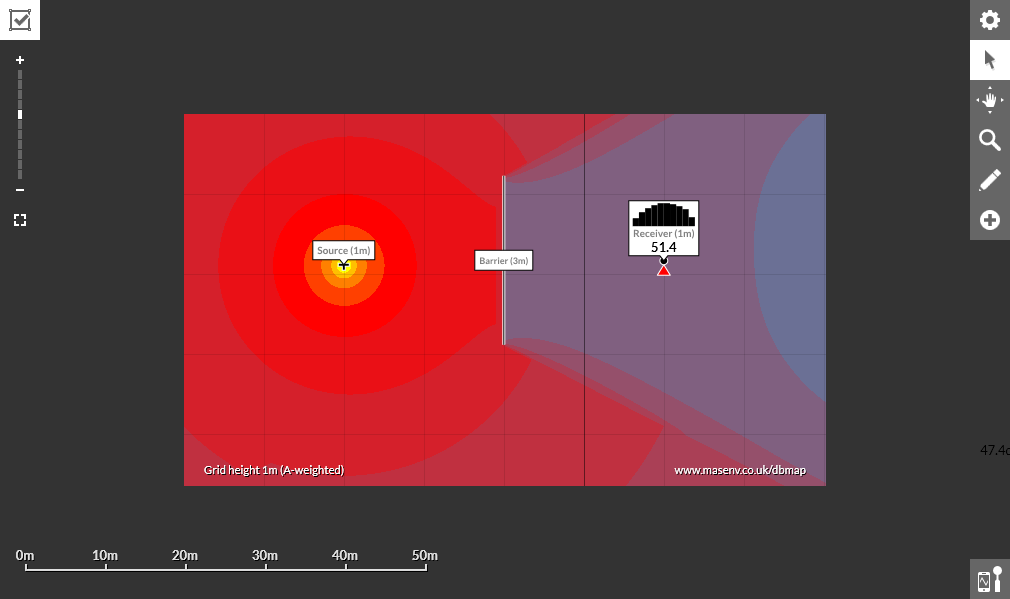Our services in noise mapping (sound level modelling) and some information about accuracy and reliability.
What is noise mapping?
Sound modelling has become an increasingly popular tool in acoustics, often for assessing the impact of potential developments or for predicting the effects of noise mitigation methods. Using formulae for predicting the creation and propagation of sound that are provided in various standards and guidance and combining this with illustrative tools and visual aids it is possible to calculate and map out decibel levels, providing useful information that can help acoustic professionals.
From modelling sound sources using real-world measured levels that are converted into sound power levels, or using sound power levels provided by manufacturers that have been taken in laboratory environments, it's possible to model the propagation of the noise generated by these objects in various scenarios. By taking traffic information or spot measurements and combining them with aerial views it is possible to map out the effects of an existing road on a hypothetical development, or predict the screening required to bring levels below the requirements given for minimising health effects.
Looking to create your own model?
We have developed our own free-to-use sound modelling software providing a simple tool for those interesting in mapping noise either for professional or educational purposes.
For more information, please visit our sound level tools page
How accurate and reliable is noise mapping?
Whilst the science of acoustics and how sound travels through the atmosphere is fairly well understood, it is important to remember that the calculations provided by noise mapping software are estimations that rely on accurate inputs. The degree of error, i.e. how inaccurate these calculations might be, will increase for each instance of the model simplifying a more complex situation. An example of this is when a source is modelled as omnidirectional, losing any directivity that is inherent. Another example is using a line source to model a moving point source which assumes the source level is consistent throughout the entire movement. Sometimes complex building structures are reduced to simple boxes. Atmospheric effects might be ignored. There may be significant reflected sound paths around objects with surface absorption and ground effects reducing certain frequencies that are easily misrepresented.
For these reasons we always attempt to minimise our reliance on noise mapping and the levels calculated. We believe that noise mapping is very useful but should be used only where real-world measurements are not possible, for example when predicting what height of barrier would be necessary to reduce a noise source to a certain level or to predict what impact a potential site development would create.
Using noise mapping to predict the noise reduction effect of an acoustic barrier.
Noise mapping is an excellent tool for predicting the efficacy of an acoustic barrier. This is because firstly the acoustic effect of barriers is fairly well understood and secondly because the effect of the barrier is the same regardless of the level of the noise source, therefore accurate source level values are not necessary.
Using noise mapping in place of a sound level meter.
We try to avoid using predicted sound levels when it is possible to take real-world measurements. This is to rule out any potential error and loss of accuracy, including not using road counts to estimate the sound level of a road as a replacement of measuring the road with a sound level meter.
A noise impact assessment with a noise map
When a noise impact assessment includes calculations from noise mapping software, it’s essential that enough information is included with the noise map to recreate these calculations again. This is because the calculations used cannot be included in detail and it is possible for mistakes to have been made in the process. Software and the guidance that it is based on becomes increasingly complex in the attempt to model all the features of a real-world acoustic environment. The chosen values for the configuration can have large effects on the resulting decibel level at a certain location and it should be possible to inspect this configuration.
The importance of topography and building height
Ground height and building heights can be hugely important in noise mapping results by affecting the sound path-lengths and barrier efficacy. However, the ground levels used for modelling often cannot be easily inspected from a resulting noise map included with a noise impact assessment. Vertical noise maps and section views can help with inspecting the height accuracy. At MAS we always seek the most accurate sources for ground heights using Ordinance Survey data, site visits and camera inspection using a drone.
Please contact us to find out more about our noise mapping services.

